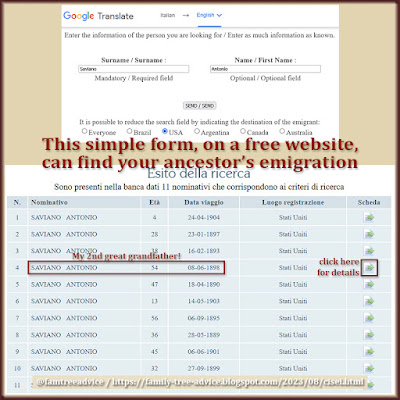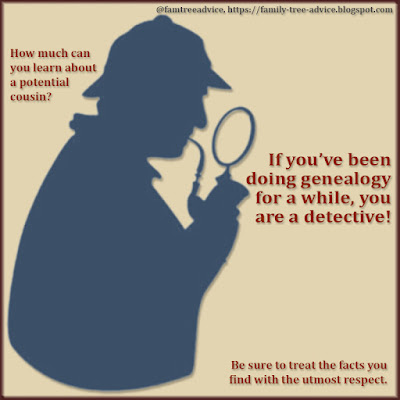I'll bet we all do it. We save notes or bookmarks to remind us of a genealogy find we need to explore. And then we forget all about it. I found a web address and single sentence on line 420 of my constantly updated text file named Notebook.txt. It says this:
http://www.ciseionline.it/portomondo
Search for family names; based on dates and ship names, piece together families.
 |
| Search 5 countries at once on this free website to see where your cousins disappeared to. |
This free-access Italian website belongs to CISEI, an organization that translates to the International Center for Italian Emigration Studies. The site provides a simple search form that lets you find Italian relatives who emigrated to:
- Brazil
- The United States
- Argentina
- Canada
- Australia
And you can search all 5 locations at once.
The key benefits of this site, which does not show you the actual ship manifests, are:
- Italians compiled much of the information. They're less likely to mangle the spelling of an Italian name.
- You'll get each key detail from a manifest typed out clearly and with great care.
- You'll get details about the ship, a photo*, migration statistics, and links to more information.
* The photo may not be the actual ship, but it will say so. - You'll see a map of the long migration path across the ocean.
- It's free!
Start Your Search with a Name
Remember, you can copy the site's URL into Google Translate and click the result to see the site in your language.
To use the search form:
- Enter a last name in the first box. This is mandatory. Wild characters like * and ? do not work. Incomplete names do not work.
- Enter a first name if you choose. This can be helpful if you would otherwise get too many results.
- Choose a destination country, or keep the Everyone/Tutti selection, to search all available ports at once.
- Click the button to submit your search.
To test this search engine, I searched for a record I know very well. It's my 2nd great grandfather's 1898 trip back to America with his whole family. He'd been to New York 2 or 3 times before this, and the last time, he left his eldest son in the Bronx to await the whole family.
When you find the result you want, click the icon in the column on the right. You'll see a full transcript of this line from the ship manifest. I was happy to see that the results were all correct. I already knew the ship name (California). I knew my relatives were heading to 149th Street in the Bronx, New York. I knew they were joining the eldest son in the family, Simplicio Saviano.
A second search for only the last name Saviano let me find the rest of the family. I already saw that the arrival date was 8 June 1898 (written here as 08/06/1898), so they were easy to spot.
With a few more clicks, I found:
- 13 people named Saviano who emigrated to Brazil
- 6 who went to Argentina
- 8 who went to Australia
- 122 who came to the USA.
I can check my family tree and vital records to try to identify cousins in these lists.
 |
| The immigration path looks daunting, doesn't it? Find out more about your ancestor's journey. |
Be on the Lookout
The main page tells you which years this database includes for which ports. There's such a variety that I won't list them here. But if you don't find your person, check to see if the database covers their year of arrival.
I didn't find my great grandparents' arrival in July 1899, and the website says it should be there. I didn't find either of my grandfathers' arrivals, either. Still, I'm excited by what I can learn from this very concentrated database of emigrants. I'm especially interested in family members who went to Australia, Argentina, and Brazil. They could help tie up some loose ends.
I noticed a few name abbreviations that tell me that's how the manifest shows the name. For instance, I found one Francesco Iamarino listed as "FCO." complete with the period at the end. Another Francesco is "FRANCO" on his manifest. Yet another, this one a Francesco Saverio, is "FRANO.SAVO." These people will be harder to find, so you should leave the first name blank on the search form and try again.
Once you've done a search or two, you shouldn't need Google Translate to get the facts you want. Some headings on the pages are images, so Google can't translate them for you. But, with the Google Translate app on your phone, you can aim your phone at the screen to see a translation. (If you're doing the search on your phone, you may need to borrow a second phone!)
Hurray! Another genealogy project! How late can you stay up tonight?
And speaking of immigration:






